Millar, Sean (2021) Drug-related infectious diseases in Ireland, 2020. Drugnet Ireland, Issue 79, Autumn 2021, pp. 38-43.
| Preview | Title | Contact |
|---|---|---|
|
PDF (Drugnet Ireland 79)
1MB |
The Health Protection Surveillance Centre (HPSC) is Ireland’s specialist agency for the surveillance of communicable diseases. Part of the Health Service Executive (HSE), and originally known as the National Disease Surveillance Centre, the HPSC endeavours to protect and improve the health of the Irish population by collating, interpreting, and disseminating data to provide the best possible information on infectious diseases. The HPSC has recorded new cases among injecting drug users of HIV since 1982, HBV (hepatitis B virus) since 2004, and HCV (hepatitis C virus) since 2006. The figures and tables presented in this summary are based on data extracted from the Computerised Infectious Disease Reporting (CIDR) System in July 2021.1 It should be noted that due to the Covid-19 pandemic and related lockdowns, HIV, HBV, and HCV notification data for 2020 are incomplete. Consequentially, these data have not yet been extensively validated and should be considered provisional.
Main drug-related infectious diseases among people who use drugs – HIV, HBV, and HCV
HIV notifications, 2020
According to data compiled by the HPSC, at the end of 2020, some 449 people were newly diagnosed with HIV in Ireland, a notification rate of 9.4 per 100,000 population. This marks a decrease of 16% compared with 2019 (n=535) (see Figure 1).
Of the HIV notifications in 2020:
- 106 were male and 42 were female.
- 85 were men who have sex with men.
- For 67% (301) of the HIV notifications in 2020, there was no reported risk factor, although this is likely to change as more data become available.
In 2020, some eight HIV notifications were of people who inject drugs (PWID), compared with 11 in 2019 (see Table 1). The figure for 2020 is the lowest number of PWID among HIV notifications since 2003 (see Figure 2).
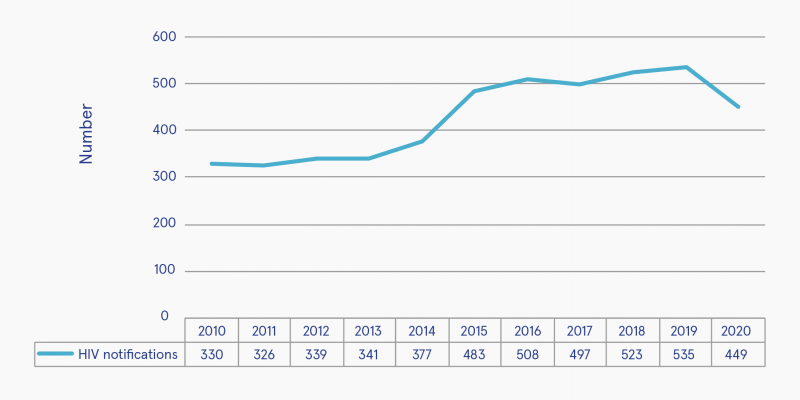
Source: HSE and HPSC (2021)
Figure 1: Number of new HIV notifications reported in Ireland, by year of notification, 2010–2020
Table 1: New HIV notifications reported to the HPSC by risk factor status, 2020
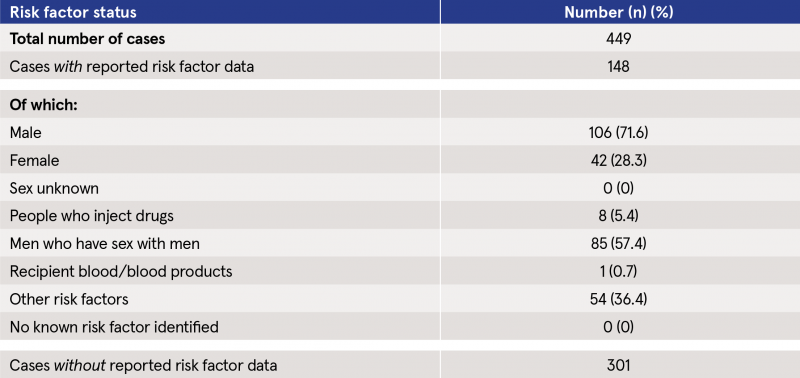
Source: HSE and HPSC (2021)
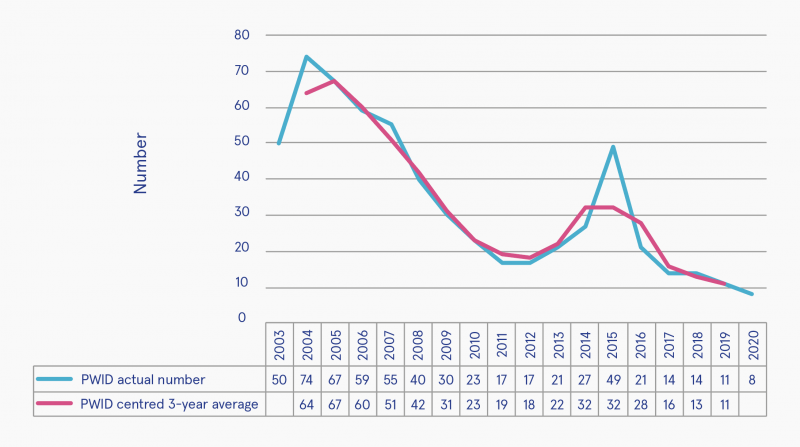
Source: HSE and HPSC (2021)
Figure 2: Number and rolling average number of PWID among HIV notifications reported in Ireland, by year of notification, 2003–2020
Of the eight PWID among HIV notifications in 2020, four were male and four were female, with a median age of 36 years. No subjects were under 25 years of age (see Table 2). The increased number of PWID among HIV notifications in 2014/15 was due to an outbreak of HIV among homeless people in Dublin who use drugs. The outbreak was declared over in February 2016. Key control measures implemented included raising awareness among clinicians, addiction services, and PWID; intensive case finding and contact tracing; early treatment of HIV infection in those most at risk; greater promotion of needle exchange; increased access to methadone treatment; frontline worker training; and raising awareness about safe injecting and safe sex. Leaflets were distributed in hostels and settings in Dublin where patients/clients attended.
HBV notifications, 2020
There were 337 notifications of HBV in Ireland in 2020, a decrease of 36% on 2019, when there were 526 notifications. The notification rate for 2020 was 7.1 per 100,000 population. HBV notifications halved between 2008 (n=897; 21.2/100,000 population) and 2014 (n=442; 9.3/100,000 population). Although provisional data on HBV notifications in 2020 are considerably lower than those reported in 2019, it should be noted that recent trends have suggested that the number of cases diagnosed and notified is stabilising rather than continuing to decline (see Figure 3).
Seventy-nine per cent (n=266) of the 337 HBV notifications in 2020 contained information on acute/chronic status. Of these, 96.2% (n=256) were chronically infected (long-term infection), while 3.8% (n=10) were acutely infected (recent infection). Risk factor data were available for eight of the acute cases notified in 2020. Of these acute cases, none was a person who injects drugs (see Table 3).
Table 2: Characteristics of new HIV notifications who reported injecting drug use as a risk factor, 2020
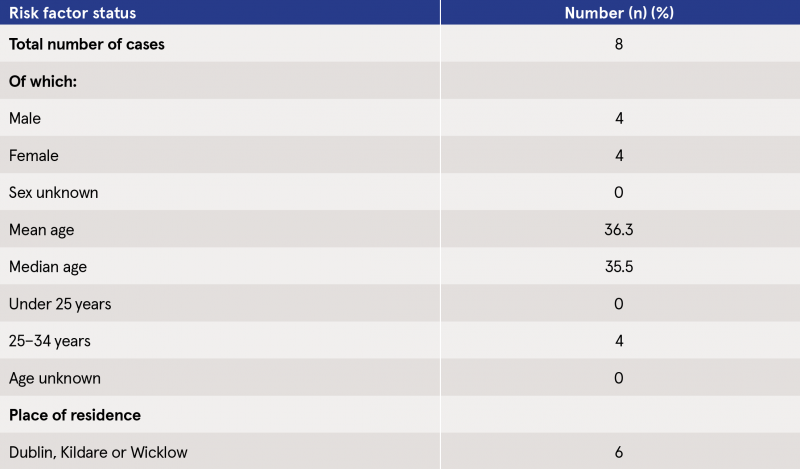
Source: HSE and HPSC (2021)
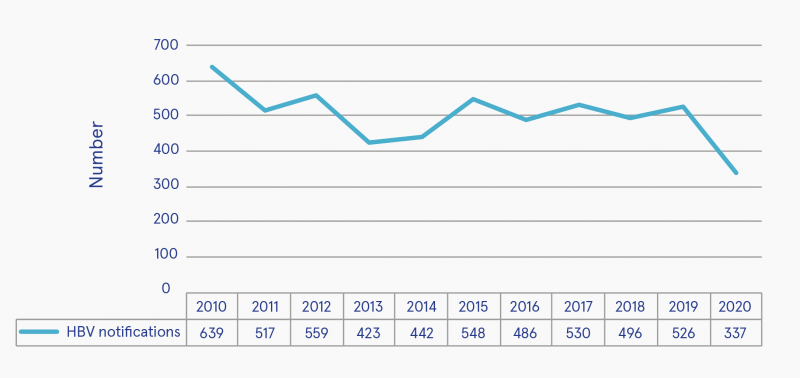
Source: HSE and HPSC (2021)
Figure 3: Number of HBV notifications reported in Ireland, by year of notification, 2010–2020
Table 3: Acute and chronic new HBV cases reported to the HPSC, 2020

Source: HSE and HPSC (2021)
Data excluding proxy risk factor of born in endemic country/asylum seeker.
HCV notifications, 2020
There were 326 HCV notifications in Ireland in 2020, a decrease of 31.2% on 2019, when there were 474 notifications. The notification rate for 2020 was 6.8 per 100,000 population. There has been a downward trend in HCV notifications since peak numbers (n=1538) were recorded in 2007. While provisional data on notifications from 2020 suggest a continued decline (see Figure 4), trends in notifications of HCV are difficult to interpret as acute and chronic infections are frequently asymptomatic, and most cases diagnosed and notified are identified as a result of screening in key risk groups. Therefore, notification patterns are highly influenced by testing practices, which may vary over time and may not reflect incidence very well.
Information on the most likely risk factor was available for 46.9% (n=153) of cases in 2020 (see Table 4). Eighty cases with risk factor data were PWID and six were infected through contaminated blood products. No risk factors were identified for 14 cases, for whom risk factor data were available despite public health follow-up.
The proportion of cases attributed to injecting drugs decreased from 88% in 2011 to 67% in 2019, but risk factor data were not available for a significant number of cases. Hence, this finding is difficult to interpret. The number of cases that were PWID among provisional HCV notification data for 2020 is also likely to be a significant underestimate. Data for 2020 will improve as further validation work is carried out.
Of the PWID among HCV notifications in 2020, 54 were male and 26 were female, with a median age of 40. Seven subjects were under 25 years of age. The majority (57.5%) resided in Dublin, Kildare or Wicklow (see Table 5).
Table 4: New HCV cases reported to the HPSC, by risk factor status, 2020

Source: HSE and HPSC (2021)
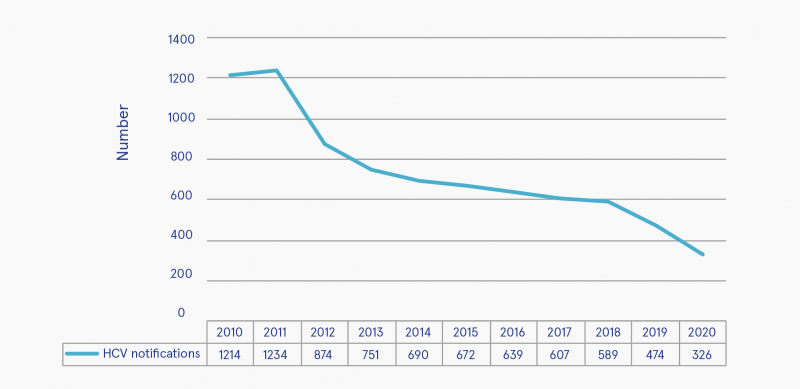
Source: HSE and HPSC (2021)
Figure 4: Number of HCV notifications reported in Ireland, by year of notification, 2010–2020
Table 5: Characteristics of new HCV notifications who reported injecting drug use as a risk factor, 2020
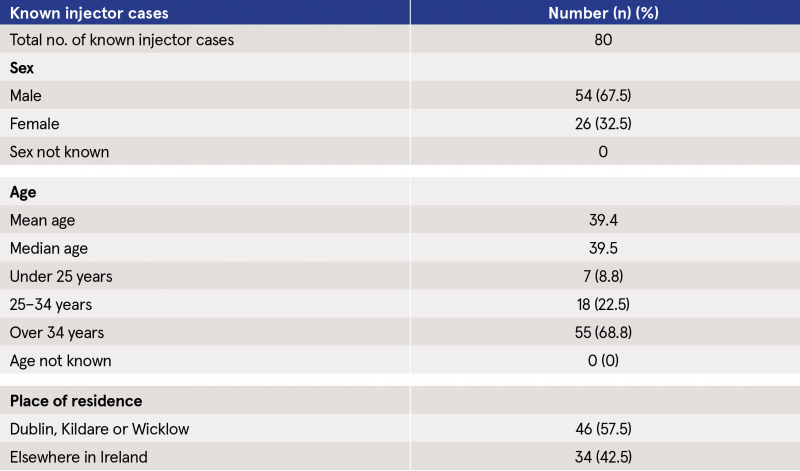
Source: HSE and HPSC (2021)
1 For further information on the CIDR System, visit: https://www.hpsc.ie/cidr/
G Health and disease > Disease by cause (Aetiology) > Communicable / infectious disease > HIV
G Health and disease > Disease by cause (Aetiology) > Communicable / infectious disease > Hepatitis B (HBV)
G Health and disease > Disease by cause (Aetiology) > Communicable / infectious disease > Hepatitis C (HCV)
J Health care, prevention, harm reduction and treatment > Harm reduction > Substance use harm reduction
T Demographic characteristics > Person who injects drugs (Intravenous / injecting)
VA Geographic area > Europe > Ireland
Repository Staff Only: item control page